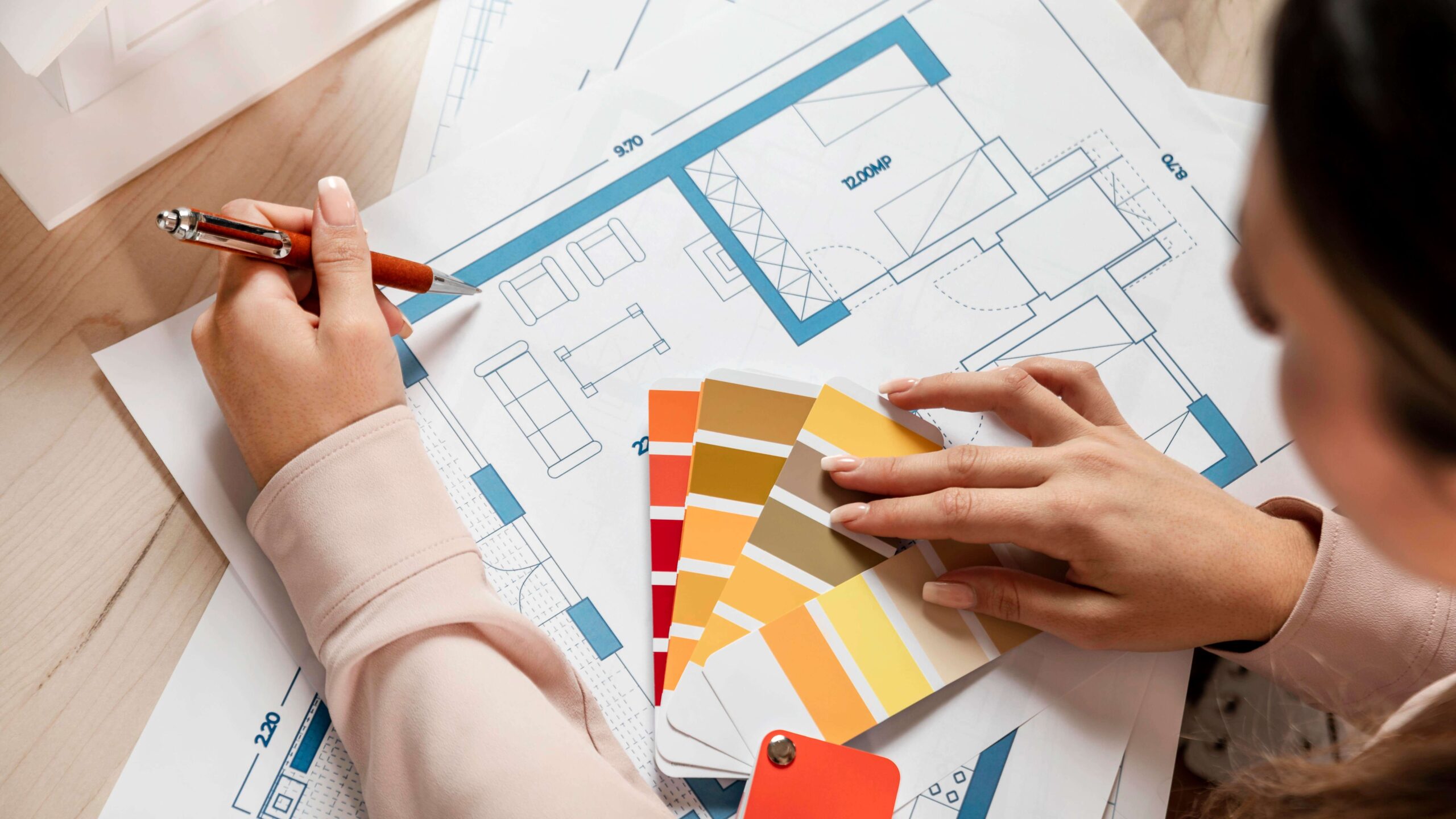
An interior decorator transforms spaces into beautiful, functional havens. Essentially, they blend art and practicality to create inviting interiors. If you’re intrigued about this career, you might wonder how to become an interior decorator. It’s a journey that involves both creativity and strategic planning. Firstly, decorators must understand colour, fabric, and furniture, and how these elements work together. It’s not just about aesthetics; functionality is key. Plus, they need to stay abreast of style trends. Building a portfolio showcasing diverse projects is crucial. This field requires continuous learning and adaptation, making it an exciting and dynamic career choice. Their work, deeply rooted in artistic vision and client needs, requires a balance of innovation and practicality.
Table of Contents
What does an interior decorator do?
Enhancing the visual appeal and practicality of interior spaces is the speciality of an interior decorator. They play a vital role in transforming rooms into visually appealing and comfortable environments. Here’s what interior decorators do:
Assessment and Consultation
Interior decorators begin by meeting with clients to understand their needs, preferences, and budgets. This initial consultation helps them gather essential information and establish a clear vision for the project.
Space Planning
They analyse the available space and layout to determine how to best utilise it. This involves considering furniture arrangement, traffic flow, and functionality to optimise the space’s potential.
Colour Selection
Interior decorators help clients choose suitable colour palettes for walls, ceilings, and other surfaces. They consider factors like lighting and the desired mood or atmosphere in the room.
Furniture and Accessories
Selecting and sourcing furniture, curtains and blinds, decor items, and accessories that align with the design concept and budget is a significant part of their job. They ensure that everything complements the overall theme.
Material Selection
Choosing appropriate materials for surfaces, such as flooring, countertops, and window treatments. They balance aesthetics, durability, and cost to make informed decisions.
Creating Mood Boards
Interior decorators often create visual mood boards or design concepts to help clients visualise the final look of the space. This aids in decision-making and ensuring client satisfaction.
Budget Management
Staying within the client’s budget is essential. Decorators meticulously budget and set aside money for all project components, such as labour, supplies, and any other costs.
Coordination with Contractors
They collaborate with contractors and tradespeople to oversee the implementation of the design plan. This involves regular site visits and ensuring that the project is progressing as intended.
Staying Updated
Interior decorators keep up-to-date with the latest design trends, materials, and technologies to provide clients with fresh and relevant ideas.
Attention to Detail
Paying close attention to details is a hallmark of a good interior decorator. They consider the smallest elements, such as hardware and trim, to ensure a cohesive and polished look.
Client Communication
Effective communication with clients is vital. Decorators must listen to feedback, address concerns, and make adjustments as necessary to achieve the desired outcome.
Final Presentation
After completing the project, interior decorators present the finished design to the client. They ensure that everything is in place and that the client is satisfied with the results.
In summary, interior decorators bring their creativity and expertise to make living spaces more appealing and functional. They collaborate closely with clients, plan and execute designs, and stay updated on design trends to deliver personalised and stylish interior solutions. Gather knowledge on how to become an interior decorator.

Interior Decorator vs. Interior Designer
Interior decorators and interior designers are professionals who play distinct but complementary roles in the world of interior design. Here’s a breakdown of their differences:
Education and Training
Interior Decorator: Typically, becoming an interior decorator doesn’t require formal education or a degree. However, completing a short course or certification program can enhance your skills.
Interior Designer: A bachelor’s degree in interior design, architecture, or a similar discipline is typically required for interior designers. They undergo comprehensive training in design principles, space planning, and building codes.
Scope of Work
Interior Decorator: Decorators primarily focus on aesthetics and decor. They select colour schemes, furniture, accessories, and other decorative elements to enhance a space’s visual appeal.
Interior Designer: Interior designers have a broader scope. They not only decorate but also plan and design spaces for functionality, safety, and compliance with regulations. This includes spatial layouts, lighting, and material selection.
Creativity vs. Technical Knowledge
Interior Decorator: Decorators use their creativity to curate beautiful interiors. They excel in selecting the right colours, patterns, and textures that align with a client’s preferences.
Interior Designer: Designers balance creativity with technical knowledge. They address structural and architectural aspects, ensuring that the space is functional and safe, as well as visually appealing.
Licensing and Regulations
Interior Decorator: In most regions, interior decorators do not require a license. They are often free to practice without specific regulations.
Interior Designer: Interior designers may need to obtain a license or certification, depending on local regulations. This is especially true if their work involves structural alterations.
Client Interaction
Interior Decorator: Decorators typically work closely with clients to understand their tastes and preferences. They translate these preferences into cohesive design schemes.
Interior Designer: Designers engage in more extensive client interactions, as their work involves not only aesthetics but also functionality. They often collaborate with architects and contractors.

In summary, interior decorators focus on enhancing aesthetics and decor and usually require less formal education. On the other hand, interior designers have a broader scope, considering both aesthetics and functionality and often require formal education and licensure. You can select the interior design path that best fits your interests and professional objectives.
What skills do you need as an interior decorator?
Embarking on a journey of how to become an interior decorator requires a blend of artistic flair and practical skills. Here’s a breakdown of the essential abilities you’ll need:
Creativity
The heart of interior decorating is creativity. It involves conceptualizing unique and appealing designs that not only look good but are also practical and functional. This skill allows you to create spaces that are both aesthetically pleasing and comfortable for the occupants.
Communication Skills
The ability to interact with suppliers, contractors, and clients efficiently is essential. This means understanding the client’s vision and translating it into a tangible design, as well as conveying ideas and changes to all involved parties.
Attention to Detail
A keen eye for detail ensures that every element, from the colour of the walls to the style of the furniture, contributes to a harmonious and attractive overall design.
Colour Theory Knowledge
An understanding of how colours interact and affect moods and spaces is critical. This skill helps in choosing the right colour schemes that can set a room’s desired tone and atmosphere.
Familiarity with Various Design Styles
Knowing various design styles enables flexibility and adaptability in catering to different client preferences, from modern minimalist to rustic country.
Organisational Skills
Effective project management, including time management, budgeting, and resource coordination, is crucial to ensure that projects are completed on time and within budget.
Trend Awareness
Keeping up with the most recent developments and design trends ensures that your designs will continue to be appealing and relevant in a market that is always evolving.
Architectural and Spatial Planning Knowledge
A basic understanding of architectural principles and spatial planning can be a huge advantage, allowing for more efficient use of space and better integration of design elements.
In conclusion, a successful interior decorator combines these skills with a passion for design and a commitment to client satisfaction. It’s a career that is as challenging as it is rewarding, offering endless opportunities to create beautiful, functional spaces. With dedication and the right skill set, anyone can excel in the fascinating world of interior decorating. Know more about how to become an interior decorator.

How to Become an Interior Decorator Online
Want to know how to become an interior decorator? Becoming an interior decorator online is a fun and exciting path. Here’s a simple, seven-step guide to help you start this creative journey.
Step 1: Research and Understand the Field
First, learn what interior decorating means. It’s all about making spaces look great. Find out what decorators do differently than designers. This step is like getting to know the basics of a new game.
Step 2: Enroll in an Online Course
Next, sign up for an online course about interior decorating. Pick one that teaches you about designing rooms, choosing colours, and picking furniture, curtains and blinds. Make sure the course is well-known and teaches you useful stuff. Join courses like – Interior Design: Styling & Staging, and Interior Design Essentials for Homeowners: Style Your Space.
Step 3: Create Your Own Style
While you’re learning, start playing with your own designs. Use computer programs to try out your ideas. Make a collection of your best work; this is like your personal showcase.
Step 4: Practice Decorating
Try your hand at decorating actual spaces. You could start with your own room, or help out friends and family. This is where you get to use what you’ve learned in real life.
Step 5: Create an Online Presence
Now, in today’s digital world, having an online presence is vital. Establish a polished website to present your work. Make use of social media sites such as Pinterest and Instagram to showcase your work and connect with other professionals and possible customers.
Step 6: Connect with Others
Talk to other people who like decorating. You can learn from them and they might help you find jobs. Join groups online, or follow other decorators to get new ideas.
Step 7: Keep Learning and Growing
Finally, always continue learning. Decorating styles and trends change, so keep up with them. Watch online videos, read articles, and try new things in your designs. Can join Studyhub courses like – Architectural & Interior Design: Modern and International Design, Mastering Colour-Architectural Design & Interior Decoration.
In conclusion, commitment, ingenuity, and a readiness to keep learning and evolving are necessary for working as an online interior decorator. By following these steps, you’re setting a strong foundation of how to become an interior decorator for a successful career in interior decorating. Remember, every great decorator started somewhere, and with the right approach, you too can achieve your dreams in this vibrant and fulfilling field.
What is the average salary for an interior decorator?
The average salary for an interior decorator varies depending on factors like location, experience, and client base, typically falling in the range of $50,000 to $60,000 annually. To become an interior decorator, you can start with a high school diploma or GED and then pursue relevant courses or degrees if desired. Gaining experience through internships or entry-level positions, building a portfolio, networking within the industry, and considering certification from organisations like IDS or NCIDQ are essential steps. As you grow your skills and clientele, you can embark on a rewarding career helping clients create beautiful and functional living spaces. Success in this field requires dedication and ongoing learning.
FAQs
Other career paths for interior decorators include becoming an interior designer, home stager, or design consultant.
A degree is not required to be an interior decorator, but formal training or certification can be beneficial.
The time it takes to become an interior decorator varies, but it typically takes a few months to a couple of years to complete relevant training and gain experience.
- All Courses
- IT & Software346
- Management263
- Teaching and Education246
- Business224
- Health and Fitness216
- Health & Safety155
- Engineering & Technology149
- Quality Licence Scheme135
- Health and Social Care130
- Healthcare127
- Accounting & Finance114
- Employability99
- Psychology98
- Lifestyle93
- Marketing72
- Office Productivity58
- Animal Care56
- Design and Photography52
- Beauty & Makeup43
- Design42
- Accounting & Bookkeeping32
- Web Development24
- Construction12
- Writing11
- Environment9
- Digital Marketing9
- Child Care8
- Agriculture5
- Coaching1
Awarded By





0 responses on "How to Become an Interior Decorator Online"